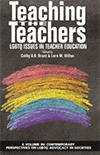
Teaching the Teachers
LGBTQ Issues in Teacher Education
Edited by:
Cathy A. R. Brant, Rowan University
Lara Willox, University of West Georgia
A volume in the series: Contemporary Perspectives on LGBTQ Advocacy in Societies. Editor(s): Lemuel W. Watson, Kinsey Institute, Indiana University. Erin A. Mikulec, Illinois State University. Kyle O'Daniel, Mahomet-Seymour High School.
Published 2020
Teacher educators have opportunities to include issues of multicultural education, equity, and social justice in the work done with preservice teachers. Including the educational and societal experiences of historically marginalized populations in curriculum creates spaces for teacher educators to model multicultural and social justice based pedagogies, while preparing teachers to work with and work for these students.
The most effective way for teacher educators to address the unique perspectives of historically and currently marginalized populations is to integrate various perspectives throughout the curriculum (Grant & Zwier, 2012). Most teacher education programs address diverse populations via an integrated approach. In fact, Sherwin and Jennings (2006) found that potential student experiences regarding social class, race, and special needs populations were typically integrated into the curriculum, however, lesbian, gay bisexual, and transgender (LGBT) issues were not. There is research that demonstrates how carefully planned and implemented educational interventions can have a positive effect on preservice teachers’ knowledge of and attitudes toward gays and lesbians (Butler, 1999).
Despite the positive impact of addressing LGBTQ issues as a part of the teacher preparation program, Gorski et al. (2013) found that LGBTQ issues receive significantly less class time than other issues, especially race, and are, in fact, eight times more likely to actually be omitted from multicultural teacher educator courses. The inclusion of LGBT topics is important for a myriad of reasons. Most importantly, studies (GLSEN & Harris Interactive, 2012; Kosciw, Greytak, Diaz, Bartkiewicz, 2010, 2012; Kosciw, Greytak, Palmer, Boesen, 2014; Kosciw, Greytak, Giga, & Danischewski, 2016) have revealed a negative school climate for students who identify as gay, lesbian, bisexual, or transgender; this hostile environment can have dire consequences for these students. The impact of bullying and harassment due to LGBTQ students’ gender and/or sexual identities can produce a number of negative effects, including isolation from friends and family, depression, drug and/or alcohol use and addiction, low selfesteem, lack of engagement in school, academic failure, and fighting (Beam, 2007; Holmes & Cahill, 2004; Kosciw et al., 2010, 2012; Kosciw et al, 2014; Kosciw et al, 2016,
Meyer, 2010; Wilkinson & Pearson, 2009).
The negative climate does not just come from peer-to-peer negative interactions. In the most recent GLSEN study (Kosciw et al, 2016) it was found that
• 57.6% of LGBTQ students who were harassed or assaulted in school did not report the incident to school staff, most commonly because they doubted that effective intervention would occur or the situation could become worse if reported.
• 63.5% of the students who did report an incident said that school staff did nothing in response or told the student to ignore it.
• 56.2% of students reported hearing homophobic remarks from their teachers or other school staff, and 63.5% of students reported hearing negative remarks about gender expression from teachers or other school staff
The aim of this book is to support teacher educators as they engage in the work of preparing pre-service teacher to work with and work for LGBTQ youth through explicit discussions of gender and sexuality. Chapters for this book include personal anecdotes regarding shifts in author’s thinking about including LGBTQ as a part of teacher preparation; specific pedagogical practices employed by authors to present LGBTQ focused material as a part of their coursework; the resistance authors have faced from students, parents and administration and their responses.
CONTENTS
Introduction: Teaching the Teachers: The Need for LGBTQ Inclusive Teacher Preparation, Cathy A. R. Brant & Lara Willox. I Have Come to a Greater Knowledge of God and His Plan: The Affordances of Queer Pedagogy to Prepare Religious Preservice Teachers to Serve LGBTQ Students, Roni Jo Draper. Sharing Practices to Help Teachers Provide Supportive and Safe Classrooms, Judith S. Kaufman and Pia Ferrante. Unlearning Heteronormativity: A Framework for Talking About LGBTQI Children in Teacher Education, Peggy Shannon-Baker. Crusading into the Unknown: Finding and Using LGBTQ Primary Sources in Teacher Preparation, Leia K. Cain and Bretton A. Varga. Queering Stories with Pre-Service Teachers, Kimberly Cosier. (Re)Storying School Experience and Transforming Teacher Education: Writing a New Narrative for LGBTQ Students, Kathy Carter, Amanda T. Sugimoto, Kathleen J. Stoehr, and Griff Carter. Shifting from Knowing What to Knowing How: Centering Queer Knowledges and Activist Teaching Narratives in English Education, Ryan Schey. Queer Theory and the Social Studies: Engaging with Histories, Communities, and Identities, Mark Helmsing. Independent Queer: LGBTQ Educators in Independent Schools Speak Out, Philip McAdoo.
-
Paperback978-1-64113-830-7
Web price: $45.04 (Reg. 52.99)
-
Hardcover978-1-64113-831-4
Web price: $80.74 (Reg. 94.99)
- eBook978-1-64113-832-1

- EDU053000 - EDUCATION: Training & Certification
- EDU048000 - EDUCATION: Inclusive Education
- EDU029070 - EDUCATION: TEACHING METHODS & MATERIALS: Health & Sexuality
-
 Affirming Identity, Advancing Belonging, and Amplifying Voice in Sororities and Fraternities
Affirming Identity, Advancing Belonging, and Amplifying Voice in Sororities and Fraternities
-
 Expanding the Vision of Faculty Learning Communities in Higher Education
Emerging Opportunities for Faculty to Engage Each Other in Learning, Teaching, and Support
Expanding the Vision of Faculty Learning Communities in Higher Education
Emerging Opportunities for Faculty to Engage Each Other in Learning, Teaching, and Support
-
 Promoting Equitable Classroom Practices in Higher Education
Approaches Beyond Curriculum
Promoting Equitable Classroom Practices in Higher Education
Approaches Beyond Curriculum
-
 Queer & Trans Advocacy in the Community College
Queer & Trans Advocacy in the Community College
-
 Queer People of Color in Higher Education
Queer People of Color in Higher Education
-
 The Handbook for Aspiring Higher Education Leaders
The Handbook for Aspiring Higher Education Leaders
-
 Unheard Voices
A Collection of Narratives by Black, Gay & Bisexual Men
Unheard Voices
A Collection of Narratives by Black, Gay & Bisexual Men

